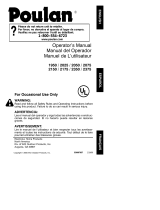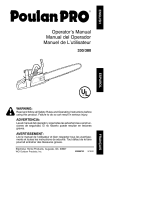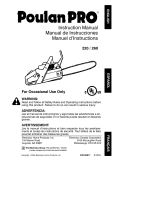
PANTY LASTS OR THE EXCLUSION OR
LIMITATIONS OF INCIDENTAL OR CONSE-
QUENTIAL DAMAGES, SO THE ABOVE
LIMITATIONS OR EXCLUSION MAY NOT
APPLY TO YOU,
ELECTROLUX HOME PRODUCTS NORTH
AMERICA'S policy is to continuously improve
its products, Therefore, ELECTROLUX
HOME PRODUCTS NORTH AMERICA re-
serves the right to change, modify, or discontin-
ue models, designs, specifications, and acces-
sories of all products at any time withoL_ notice
or obligation to any purchaser.
YOUR WARRANTY RIGHTS AND OBLIGA-
TIONS: The U. S. Environmental Protection
Agency and POULANNVEED EATER, DIVI-
SION OF WCI OUTDOOR PRODUCTS are
pleased to explain the emissions control sys-
tem warranty on your lawn and garden equip-
ment engine. All new utility and lawn and gar-
den equipment engines must be designed,
built, and equipped to meet the stringent anti-
smog standards. POULAN/WEED EATER
must warrant the emission control system on
your lawn and garden equipment engine for the
pededs of time listed below provided there has
been no abuse, neglect, or improper mainte-
nance of your lawn and garden equipment en-
gine. Your emission control system includes
parts such as the carburetor and the ignition
system. Where a warrantable condition exits,
POULANNVEED EATER will repair your lawn
and garden equipment engine at no cost to
you. Expenses covered under warranty in-
clude diagnosis, parts and labor. MANUFAC-
TURER'S WARRANTY COVERAGE: If any
emissions related pad on your engine (as listed
under Emissions Control Warranty Parts List)
is defective or adefect in the materials or work-
manship of the engine causes the failure of
such an emission related part, the part will be
repaired or replaced by POULAN/WEED EAT-
ER, OWNER'S WARRANTY RESPONSIBI-
LITIES: As the lawn and garden equipment en-
gine owner, you are responsible for the
performance of the required maintenance
listed in your Owner's Manual. POULAN/
WEED EATER recommends that you retain all
receipts covering maintenance on your lawn
and garden equipment engine, but POULAN/
WEED EATER cannot deny warranty solely
for the lack of receipts or for your failure to en-
sure the performance of all scheduled mainte-
nance. As the lawn and garden equipment
engine owner, you should be aware that POU-
LAN/WEED EATER may deny you warranty
coverage if your lawn and garden equipment
engine or a part of it has failed due to abuse,
neglect, improper maintenance, unapproved
modifications, or the use of parts not made or
approved by the edginal equipment manufac-
turer. You are responsible for presenting your
lawn and garden equipment engine to a POU-
LAN/WEED EATER authodzed repair center
as soon as a problem exists, Warranty repairs
should be completed in a reasonable amount
of time, not to exceed 30 days, If you have any
questions regarding your warranty rights and
responsibilities, you should contact your near-
est aL_hoitzed service canter or call POULAN/
WEED EATER at 1-800-554-6723, WAR-
RANTY COMMENCEMENT DATE: The
warranty period begins on the date the Fawn
and garden equipment engine is purchased.
LENGTH OF COVERAGE: This warranty
shall be for a period of two years from the initial
date of purchase. WHAT IS COVERED: RE-
PAIR OR REPLACEMENT OF PARTS. Re-
pair or replacement of any warranted part will
be performed at no charge to the owner at an
approved POULAN/WEED EATER servicing
canter. If you have any questions regarding
your warranty rights and responsibilities, you
should contact your nearest authorized service
center or call POULAN/WEED EATER at
1-800-554-6723 WARRANTY PERIOD:
Any warranted part which is not scheduled for
replacement as required maintenance, or
which is scheduled only for regular inspection
to the effect of "repair or replace as necessary"
shall be warranted for 2years. Any warranted
part which is scheduled for replacement as re-
quired maintenance shall be warranted for the
period of time up to the first scheduled replace-
ment point for that part. DIAGNOSIS: The
owner shall not be charged for diagnostic labor
which leads to the determination that a war-
ranted part is defective if the diagnostic work is
performed at an approved POULAN/WEED
EATER servicing center. CONSEQUENTIAL
DAMAGES: POULAN/WEED EATER may
be liable for damages to other engine compo-
nents caused by the failure of a warranted pad
still under warranty. WHAT IS NOT COV-
ERED: All failures caused by abuse, neglect,
or improper maintenance are not covered.
ADD-ON OR MODIFIED PARTS: The use of
add-on or modified parts can be grounds for
disallowing a warranty claim. POULAN/WEED
EATER is not liable to cover failures of war-
ranted parts caused by the use of Odd-on or
modified parts. HOW TO FILE A CLAIM: If
you have any questions regarding your war-
rarity dghts and responsibilities, you should
contact your nearest authorized service center
or call POULANNVEED EATER at
1-800-554-6723. WHERE TO GET WAR-
RANTY SERVICE: Warranty services or re-
pairs shall be provided at all POULAN/WEED
EATER service centers, call:
1-800-554-6723 MAINTENANCE, RE-
PLACEMENT AND REPAIR OF EMISSION
RELATED PARTS: Any POULAN/WEED
EATER approved replacement part used in the
performance of any warranty maintenance or
repair on emission related pads will be pro-
vided without charge to the owner if the part is
under warranty. EMISSION CONTROL
WARRANTY PARTS LIST: Carburetor, Igni-
tion System: Spark Plug (covered up to main-
tenance schedule), ignition Module. MAINTE-
NANCE STATEMENT: The owner is
responsible for the performance of all required
maintenance as defined in the owner's manual.
13

















